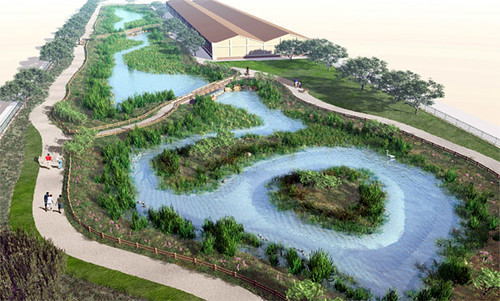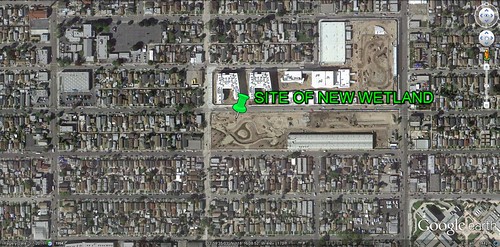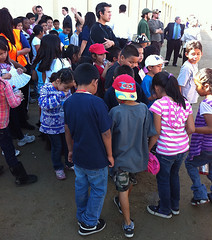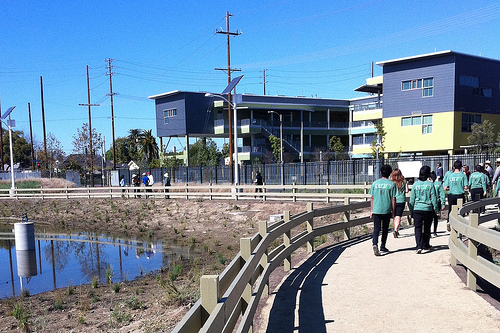New wetlands park made possible by environmental justice lawsuit
A densely packed, distressed neighborhood in South Los Angeles has a new, nine-acre park that will include a 4.5-acre wetland, filtering stormwater while bringing much-needed green space into a community historically plagued by nearby industrial facilities. Even better, the park replaces a former brownfield, a paved bus and rail storage yard long maintained by the Metropolitan Transit agency. The park will include native trees and plant gardens, walking trails and ponds. The grand opening was held earlier this month.
The $26 million project was funded in part through a 2004 settlement agreement reached in a lawsuit brought by the US Department of Justice (where yours truly worked back in the day), the state of California, and the Santa Monica Baykeeper against the city of Los Angeles under the federal Clean Water Act to force cleanup of the city's sewer system. A number of local citizens and civil rights groups joined the suit in support of the claim. Under the settlement, the city did not admit legal liability but agreed to a $2 billion program "to reduce Sanitary Sewer Overflows to the maximum extent feasible, and to investigate, resolve, and mitigate sewer odors."
Funding was also provided under multiple federal and local programs, including a local bond measure passed in 2004 to support water quality improvement projects. This is how the city's application described its proposal:
"The Wetland Park is proposed to include stormwater pre-treatment best management practices (BMP) measures, a stormwater treatment wetland of approximately 4.0 to 4.5 acres, renovation of an 81,760 square foot on-site structure, open park space, and a parking lot with a vegetated swale to direct runoff into the wetland. The Wetland Park will provide educational opportunities and wildlife viewing, historical railway elements, a community multi-use center, and historical building reutilization . . .
"The Wetland Park will assist in minimizing the introduction of pollutants including; bacteria, oil & grease and gasoline, suspended sediments, and heavy metals, all of which are components of urban runoff that ultimately are washed into receiving waters . . . Park amenities include trails, boardwalks, observation decks, picnic areas, a natural rock-garden seating area, educational signage, and renovation of an 81,760 square-foot on-site building for mixed public use."
You can see the building, a former garage, in the images accompanying this post. It will eventually become an education center and rail museum.
Writing for KCET-TV, Ed Fuentes hailed the green infrastructure benefits of the project, citing statements by city officials and some very important stakeholders:
"Other experts who may have insight on the perceived success of the park were the children who attended the ribbon cutting. When a group from 49th Street Elementary School were asked if they would miss a soccer field,
they all agreed that this park is just as important. 'Birds need a place to play, too' said one fourth-grader."
On the Outside website, Mary Catherine O'Connor observes that, although the new park needs time to mature, another fully functioning artificial wetland - built a mile away in 2006 - suggests that birds, turtles, "and even an egret" may soon be among the new site's inhabitants. O'Connor also notes that the new park is part of a larger effort to clean up the Los Angeles River Watershed, itself part of a seven-city federal pilot program that includes watershed restoration projects on the Anacostia River in DC and Maryland, the Bronx and Harlem rivers, Denver's South Platte River and Lake Pontchartrain in New Orleans.
At full capacity, the South Los Angeles Wetlands Park will be able to process up to 680,000 gallons of stormwater each day.
The Santa Monica Baykeeper is a frequent partner and client in NRDC's efforts to bring the benefits of a clean watershed to all LA residents. The environmental justice group The City Project summed up what the new park represents:
"This work in and out of court is a best practice example of community groups, civil rights attorneys, government agencies at the federal, state and local level, and mainstream environmentalists working together to improve quality of life, human health, and environmental quality and justice for all."
To this writer, it appears to be exactly that.
Kaid Benfield writes (almost) daily about community, development, and the environment. For more posts, see his blog's home page. Please also visit NRDC's Sustainable Communities Video Channel.






